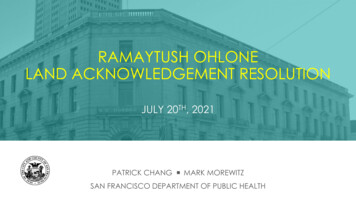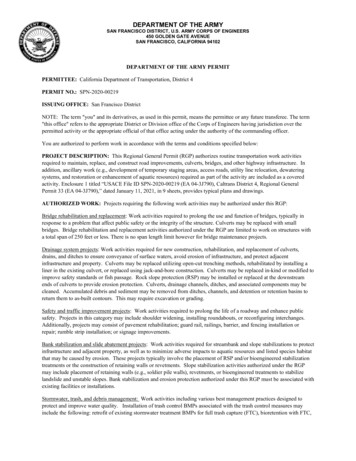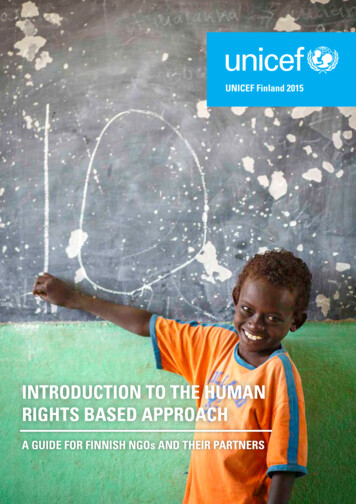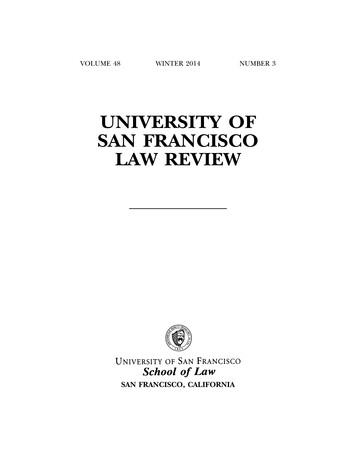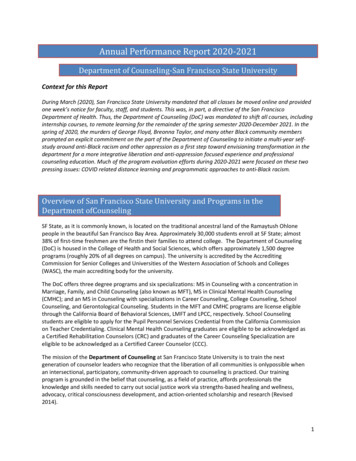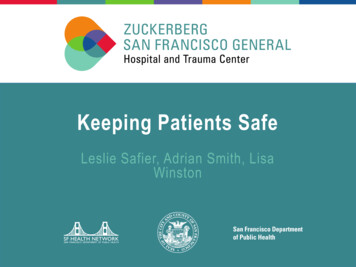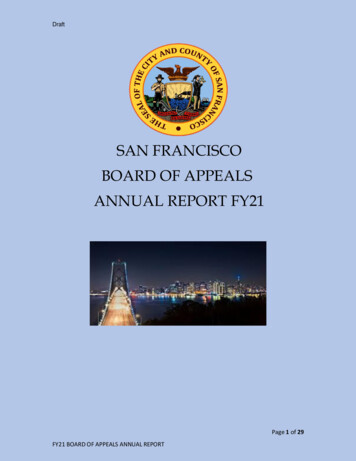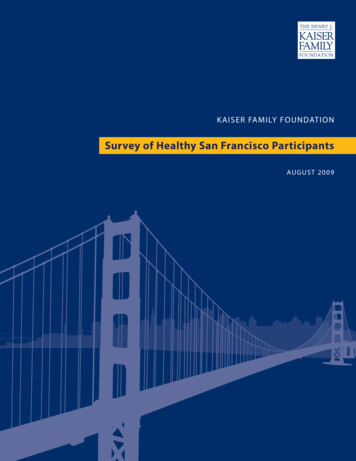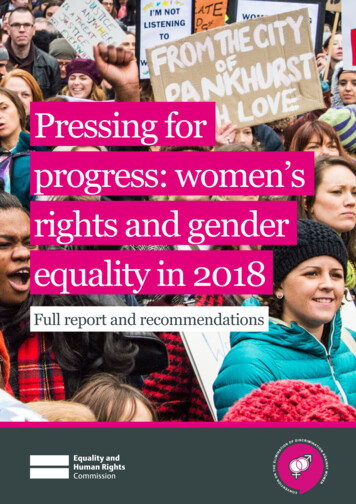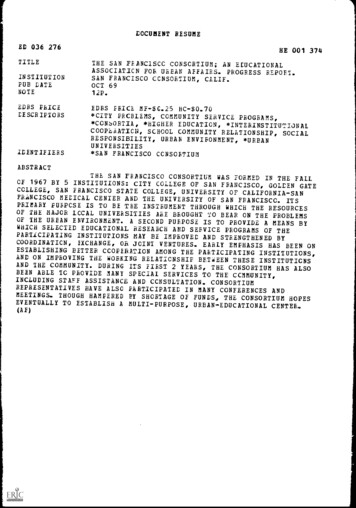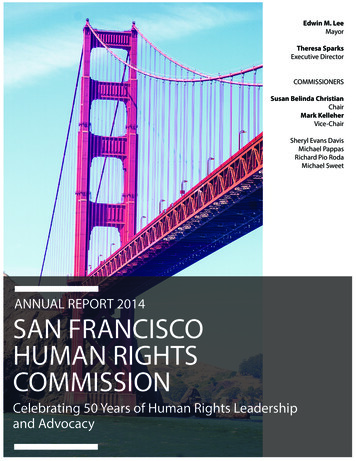
Transcription
Edwin M. LeeMayorTheresa SparksExecutive DirectorCOMMISSIONERSSusan Belinda ChristianChairMark KelleherVice-ChairSheryl Evans DavisMichael PappasRichard Pio RodaMichael SweetANNUAL REPORT 2014SAN FRANCISCOHUMAN RIGHTSCOMMISSIONCelebrating 50 Years of Human Rights Leadershipand Advocacy
Table of ContentsI.Message from Executive Director Theresa Sparks . 1II.Agency History and Governing Laws . 2III.The Commission and Message from Commission Chair Susan Belinda Christian . 3IV.2014 Highlights . 4 Awards and Recognitions . 4Community Engagement . 4Digital Outreach Initiative . 8Outreach and Awareness Campaigns . 11Reflections . 14V.2014 HRC Hero Awards . 15VI.Policy & Social Justice Division Overview and 2014 Performance Data . 17 VII.Fair Chance Ordinance . 18International Initiatives . 20 International Human Rights Agreements . 20 Using International Human Rights in Local Context . 20 U.S. State Department International Visitors Program. 20National and Regional Collaborative . 21African American Empowerment Initiative . 22Violence Prevention Initiatives . 23Initiatives Fostering Inclusion. 23 LGBTQ Homeless Connect . 24 12(N) City Ordinance Implementation and Compliance . 24 Bisexual Inclusion . 24Impact Assessment Initiatives . 23 Human Rights Impact of the War on Drugs . 25 Post 9/11 Discrimination Against AAMEMSA Communities . 25Diversity, Sensitivity &Cultural Competency Training for Businesses, Employers and Housing Providers . 26Discrimination Division 2014 Overview . 27 VIII.Complaints Intake and Investigation Process . 27Protected Classes under SF City Law . 272014 Calendar Year Performance Data. 28Public Awareness Campaign . 30Citizen Advisory Committees. 31 LGBT Advisory Committee: Overview and Key Accomplishments. 31 LGBTAC Empowerment of Trans Women of Color and Immigration Trans Women Workgroup . 31 LGBTAC Bridging the Relationship Between the LGBT Community and the Text Sector Workgroup . 31 LGBTAC Economic Wellness for LGBT Middle Income San Franciscans Work Group . 31IX. Equity Advisory Committee: Overview and Key Accomplishments . 33 EAC African American Out Migration Workgroup. 33EAC Housing Unaffordability in San Francisco Workgroup . 33HRC Legal Clinics and Fellowships . 34 HRC Summer Law Clinic . 34 HRC Legal Fellowships . 34 HRC Partnership with UC Hastings Law School Mediation Clinic . 34X.HRC Presence in the Community . 35XI.Human Rights Commission Staff . 40XII.The Friends of the Human Rights Commission . 40
I.Message from Executive Director Theresa SparksIn 2014, the Human Rights Commission celebrated its 50th Anniversary and hadone it most innovative and transformative years to date. After more than threeyears of advocacy, the HRC celebrated the passage of the Fair Chance Ordinance,the first legislation in the country to end arbitrary discrimination against personswith arrest and conviction records in both employment and housing. Welaunched our Violence Prevention program and administered crucial financialsupport to some of San Francisco’s most underserved and vulnerablecommunities. We leverage social media to effectively engage community on theCommission’s work. And we continued to professionally and efficiently carry outour most central duty –mediating and investigating cases of discrimination.The HRC also increased our regional, national and international presencethrough taking leadership roles on the California Human Relations Organizationsand the Governing for Equity Network. As a member of the University ofCalifornia LGBT Taskforce, I carry forward HRC’s mission to systematicallyincrease LGBTQ cultural competency. On International Human Rights Day, I hadthe honor of representing the HRC at the United Nations Headquarters in NewYork, where I addressed an international audience on HRC’s work with LGBTseniors, youth and families.As we reflected on the storied history and achievements of the HRC over the lastyear and the last 50 years, we also developed plans for continuing to protect civilrights for the next 50 years. We are invested in honoring the legacy of ourcollective civil rights victories. We pledge to remain engaged and proactive.Theresa SparksExecutive DirectorSan Francisco Human Rights Commission 2014 Annual Report-1- Page
II.Agency History and Governing LawsThe San Francisco Human Rights Commission (“HRC”) provides leadership and advocacy in securing,protecting and promoting human rights for all people. For over 50 years, HRC has grown in response toSan Francisco’s mandate to address the causes of and problems resulting from prejudice, intolerance,bigotry and discrimination. HRC has the good-faith and commitment of San Francisco’s leaders to bean independent voice of human rights protection for all people and, again and again, leads the way ongroundbreaking initiatives in the realm of human and civil rights. To that end, HRC: Advocates for human and civil rights;Investigates and mediates discrimination complaints;Resolves community disputes involving individual or systemic illegal discrimination; andProvides technical assistance, information and referrals to individuals, community groups,businesses and government agencies related to human rights and social services.The roots of HRC go back to 1964 when the modern day civil rights movement manifested in SanFrancisco through demonstrations against hotels, supermarkets, drive-in restaurants and automobileshowrooms that discriminated against African Americans. In early 1964, Mayor John F. Shelleyappointed an Interim Committee on Human Relations, which subsequently recommended to the Boardof Supervisors that a permanent Human Rights Commission be established. In July 1964, the Board ofSupervisors passed the recommendation, and Mayor Shelley signed an ordinance establishing theHuman Rights Commission. From 1964, the Human Rights Commission grew in response to Citygovernment's mandate to address the causes of and problems resulting from prejudice, intolerance,bigotry and discrimination. The Mayor and the Board of Supervisors gave the Human RightsCommission more and broader powers and duties to address these problems, and passed additionalordinances, which were implemented by the Human Rights Commission. In June 1990, the voters ofSan Francisco established the Human Rights Commission as a Charter Commission. Today, HRCperforms its Charter mandated obligations and duties pursuant to the following City ordinances andlaws:San Francisco CharterArticle IV, Section 4.107: HRC as a Charter agencySan Francisco Administrative CodeChapter 12A: Powers and Duties of HRCChapter 12B: Non-discrimination in CCSF ContractsChapter 12C: Non-discrimination in CCSF Property ContractsChapter 12H: Sanctuary City OrdinanceChapter 12N: LGBT Youth Sensitivity TrainingSan Francisco Police CodeArticle 33: Non-discrimination in Housing, Employment and Public AccommodationsArticle 38: Non Discrimination based on HIV StatusArticle 49: Procedures for Considering Convictions and Arrests and Related Information inEmployment and Housing DecisionsArticle 1.2: Non Discrimination in Housing against Families with Minor ChildrenSan Francisco Human Rights Commission 2014 Annual Report-2- Page
III.The CommissionThe Mayor of San Francisco is authorized to appoint up to eleven Commissioners to the Human RightsCommission. The Commission sets policy and communicates that policy to the Executive Director whoin turn is responsible for its execution. Current Commissioners appointed to the HRC are:S USAN B. C HRISTIAN S HERYL E VANS -D AVIS M ARK K ELLEHER F AYE W OO L EE M ICHAEL G. P APPAS R ICHARD P IO R ODA M ICHAEL S WEETMessage from HRC Chair Susan Belinda ChristianWe enter 2015 inspired and invigorated by all of the events of 2014. This reportreviews the successes the Commission has had in 2014 and provides a preview andfoundation for the initiatives we are excited about in 2015. Our Commission continuesour campaign to honor and carry forward the dreams and accomplishments of the1960’s Civil Rights Movement. In 2015, we will commemorate the 50th Anniversary ofthe 1965 Voting Rights Act. Moreover, building on our mission to ensure equitableaccess to city services, we will launch our Implicit Bias Training program for citydepartments. This training program will assist departments in conducting communityengagement that is relevant and addresses the needs of San Francisco’s diversepopulation. I remain honored to work with my dedicated colleagues on the Commissionand the innovative department staff. I look forward to continuing to uplift andstrengthen our amazing city.Susan Belinda ChristianCommission ChairCommissioner Faye Woo Lee Retires after 10 Years of Service on the HRCFirst appointed in 2004, Commissioner Faye Woo Lee has been integral to many of theimportant achievements of the Human Rights Commission in last decade. Withexpertise in culturally competent and affordable healthcare as well as child welfare,Commissioner Lee led the HRC on its Education as a Human Rights Initiative as well asits engagement with local schools. She also co-chaired the Commission’s EquityAdvisory Committee and provided advice and support on many of the committee’sinitiatives including increasing literacy rates, addressing the needs of seniors andincreasing workplace safety for low income immigrant women. Admired by her fellowcommissioners and staff, Commissioner Lee maintained strong relationships withresidents throughout San Francisco’s multicultural communities. The Commission joinsthe entire city in thanking Commissioner Lee for her service.San Francisco Human Rights Commission 2014 Annual Report-3- Page
IV. 2014 HIGHLIGHTS: Awards and RecognitionsThe HRC won several awards in 2014including: San Francisco Human Rights Commission 2014 Annual ReportCertificate of Honor from DistrictAttorney George Gascon toCommissioner Sheryl Evans DavisThe Golden Gate Business Association’sProfile Encourage Award to ExecutiveDirector Theresa SparksThe LGBT Center’s BOLD Award forHRC’s violence prevention initiatives.San Francisco State University’sDisabled Students AssociationLeadership AwardFive Keys Charter School Certificate ofAppreciation2014 Alice B Toklas Legend Award:Theresa Sparks-4- Page
2014 HIGHLIGHTS: COMMUNITY ENGAGEMENTThe Human Rights Commission was proud to join the Mayor and Board of Supervisors at theAnnual Martin Luther King Breakfast and the citywide Black History Month Celebration 2014.San Francisco Human Rights Commission 2014 Annual Report-5- Page
2014 HIGHLIGHTS: COMMUNITY ENGAGEMENTThe Human Rights Commission took part in the 45th annual San Francisco Pride Celebration& ParadeSan Francisco Human Rights Commission 2014 Annual Report-6- Page
2014 HIGHLIGHTS: COMMUNITY ENGAGEMENTThe Human Rights Commission joined Mayor Edwin Lee, Senator Mark Leno, Supervisors DavidChu, Jane Kim, David Campos, and Scott Weiner the San Francisco Trans March.San Francisco Human Rights Commission 2014 Annual Report-7- Page
2014 HIGHLIGHTS: DIGITAL OUTREACHLeveraging social media, HRC reached an audience over 1,000 with an average of 5 new followersper week.San Francisco Human Rights Commission 2014 Annual Report-8- Page
2014 HIGHLIGHTS: DIGITAL OUTREACHIn addition to press releases, the HRC website, and advisory committee engagement, HRC usedonline tools including Facebook, Twitter, and Mail Chimp to increase our reach in San Francisco.audience.San Francisco Human Rights Commission 2014 Annual Report-9- Page
2014 HIGHLIGHTS: DIGITAL OUTREACHHRC’s online presence enabled us to more effectively engage the city’s diverse communities and increaseSan Franciscans understanding of the work of the HRC.San Francisco Human Rights Commission 2014 Annual Report- 10 - P a g e
APPRECIATIONS2014 HIGHLIGHTS: OUTREACH AND AWARENESS CAMPAIGNSIn 2014, the HRC hosted information sessions for tenants as well as housing providers on the Fair Chance Ordinance. Oneparticipant offered the following feedback:“Thanks for including me as part of the Fair Chance roundtable discussion. I appreciate the clarification andguidance from HRC and the comments from the roundtable participants. It made it easier to guide my staff toproperly revise the various application forms and resident selection plans to make sure we are in compliance withthe Fair Chance Ordinance.”San Francisco Human Rights Commission 2014 Annual Report- 11 - P a g e
2014 HIGHLIGHTS: OUTREACH AND AWARENESS CAMPAIGNSThe San Francisco Human Rights Commission and the Lawyers’ Committee for Civil Rights invited legalexperts, academics and community members to discuss the continuing legacy of Brown v. Board ofEducation and the successes and challenges of achieving racial equity in the San Francisco schools.San Francisco Human Rights Commission 2014 Annual Report- 12 - P a g e
2014 HIGHLIGHTS: OUTREACH AND AWARENESS CAMPAIGNSIn 2013, the HRC launched a multi-year campaign to remember the important civil rights victories of the1960’s and engage the city on the collective importance of recent human rights achievements in SanFrancisco. This year, the HRC honored the 50th Anniversary of the 1964 federal Civil Rights Act.San Francisco Human Rights Commission 2014 Annual Report- 13 - P a g e
2014 HIGHLIGHTS: REFLECTIONS*** STATEMENT ***Human Rights Commission Celebrates the Life and Work of*** MayaSTATEMENT***Dr.AngelouPoet, RightsCivil Rights Activist,and InternationallyBeloved Intellectualwill beandrememberedas anHumanCommissionCelebratesthe LifeWorkofimportantDr. Mayafigure in San Francisco’s African American HistoryAngelouMayRights28, 2104,San Francisco,CA: The HRCjoinedIntellectualMayor Edwinand the San FranciscoHuman RightsPoet, CivilActivist,and InternationallyBelovedwillLeebe rememberedas an importantfigure in SanCommission in honoring the life ofFrancisco’sDr. Maya Angelouwith the followingAfrican AmericanHistory statement:“Dr. Angelou’sbeautifulto joinedSan Franciscoin one Leeof herI KnowWhy TheCagedBirdMay 28, 2104,San Francisco,CA:tributeThe HRCMayor Edwinandfamousthe ngelouthe mostwithbeautifuland passionatewritings about our city. As a teenager, Dr.honoringSingsthe lifeof Dr. oneMayathe followingstatement:Angelou relocated to San Francisco during the Great Migration, a movement when over 6 million AfricanAmericanfamiliesleft theJim FranciscoCrow Southfor aofbetterlife in theNorthand Whythe West.She describes“Dr. Angelou’sbeautifultributeto Sanin oneher famouswork,I KnowThe CagedBird Singsherremainsexperiencemovingly:one of themost beautifuland passionate writings about our city. As a teenager, Dr. Angelou relocated to San Franciscoduring the Great Migration, a movement when over 6 million African American families left the Jim Crow South for aforthetheWest.first time,perceived myselfas part of something Thecity became for me the ideal ofbetter life“IninSantheFrancisco,North andSheI describesher experiencemovingly:what I wanted to be asa grownup. Friendly but never gushing, cool but not frigid or distant, distinguished withoutawful stiffness.”“In SantheFrancisco,for the first time, I perceived myself as part of something The city became for me the ideal of what Iwanted to be asa grownup. Friendly but never gushing, cool but not frigid or distant, distinguished without the awful“To me a 13 year old Black girl, stalled by the South andSouthern Black life style, the city was a state of beauty andstiffness.”a state of freedom I became dauntless and free of fears, intoxicated by the physical fact of San Francisco. Safe in“To me a 13 year old Black girl, stalled by the South and Southern Black life style, the1 city was a state of beauty and a statemy protecting arrogance, I was certain that no one loved her as impartially as I.”of freedom I became dauntless and free of fears, intoxicated by the physical fact of San Francisco. Safe in my protecting1arrogance, I was certain that no one loved her as impartially as I.”After attending George Washington High School, Mission High School, and California Labor School, Dr.Angelou became San Francisco’s first African American female streetcar conductor. Over several pages,After attending George Washington High School, Mission High School, and California Labor School, Dr. Angelou becameshe talks about the challenges she faced and her determination to become a “conductorette.” When sheSan Francisco’s first African American female streetcar conductor. Over several pages, she talks about the challenges shewas finally given the job, she states “on a blissful day I was hired as the first Negro on San Franciscofaced and her determinationto become a “conductorette.” When she was finally given the job, she states “on a blissfulstreetcars.”2day I was hired as the first Negro on San Francisco streetcars.”1Today, as we reread Dr. Angelou’s poems, recall the first time we heard her speak, and reflect on theToday, as we reread Dr. Angelou’s poems, recall the first time we heard her speak, and reflect on the impact she had onimpact she had on our lives, let’s also remember Dr. Angelou as a San Franciscan, and a person whoseour lives, let’s also remember Dr. Angelou as a San Franciscan, and a person whose potential was nurtured in our greatpotential was nurtured in our great city. As the Human Rights Commission works to stem Africancity. As the Human Rights Commission works to stem African American Out-Migration, we maintain the ideal that SanAmerican Out-Migration, we maintain the ideal that San Francisco can be a state of beauty and state ofFrancisco can be a state of beauty and state of freedom for everyone. We are grateful to Dr. Angelou for a lifetime offreedom for everyone. We are grateful to Dr. Angelou for a lifetime of lyrical witnessing and we honorlyrical witnessing and we honor her legacy by recommitting ourselves to human rights and human dignity for all.”her legacy by recommitting ourselves to human rights and human dignity for all.”12Angelou, Maya. I Know Why the Caged Bird Sings. New York: Ballantine Books 2009. Pgs 211-212Id at 264-270San Francisco Human Rights Commission 2014 Annual Report- 14 - P a g e
V. HRC HERO AWARDS 2014Legacy Award for Lifetime Achievement in Human RightsAdvocacyLinda Brooks Burton (post-humous)Managing librarian of the Bayview Library for 15 years and, a 30-yearveteran of the San Francisco Public LibraryIndividual Leadership in Civil RightsChristine HarrisBoard of Directors, Jazz Heritage Center. Started “The Musician’sProject” to educate local and new residents of the Fillmore District aboutthe impact jazz made in the Fillmore community.Mary Wardell-GhirarduzziVice Provost & Chief Diversity and Community Engagement Officer atUniversity of San Francisco, leverages the USF mission and commitmentto diversity and inclusion to strengthen the campus for students, facultyand staff and expands the university's community engagement,particularly for multicultural and marginalized communities.Monetta WhiteEntrepreneur and Owner of 1300 Restaurant, CommunityLeader advancing Economic Development in Fillmore District,Community Youth Job Training and Professional Development Mentor.Rodney WilliamsRetired San Francisco Police Department Officer, one of first AfricanAmericans to integrate the SFPD in 1955. First African American toachieve the rank of Inspector in the SFPD.The2014 HEROAwardsHRC’s HERO awards recognizedlocal heroes for their outstandingcontributions in the field of civilrights. Nominees are submitted bythe community, and finalists areselected by HRC’s Equity AdvisoryCommittee based on theirdemonstrated commitment tohuman rights, community serviceand fostering positive changeamong the City’s diversecommunities.HRC’s 2014 Hero Awardscommemorated the 50thanniversary of the Civil Rights Actby recognizing organizations andindividuals who advance civilrights and embody the spirit andlegacy of the Civil RightsMovement. The awardspresentation took place on the50th Anniversary of when MayorJohn F. Shelley signed ordinance209-64, creating the HRC.HRC presented the awards on July24, 2014. Attended by over 150members of the public, this eventprovided an opportunity for all toreflect on the continued relevanceof the Civil Rights Act.San Francisco Human Rights Commission 2014 Annual Report- 15 - P a g e
2014 HERO Awards (continued)Organizations Advancing Civil RightsThe Economic Opportunity CouncilThe Economic Opportunity Council of San Francisco (EOC) is a private, nonprofit corporation that wasestablished under the Economic Opportunity Act of 1964, and was designated by the Board of Supervisorsto operate the Community Services Program. This mission of the Agency is to address poverty in SanFrancisco.The Fair Chance CampaignCoalition of community based organizations including, the Lawyers Committee for Civil Rights, NationalEmployment Law Project, Community Housing Partnership, All of Us or None and Legal Services forPrisoners with Children, to reform the background check process for employment and city-subsidizedaffordable housing in San Francisco.The Lawyers’ Committee for Civil RightsCombining direct legal services, policy advocacy, and impact litigation strategies, Lawyers’ Committee forCivil Rights of the San Francisco Bay Area advances the rights of immigrants, refugees and communities ofcolor, with a specific focus on low income communities and a long-standing commitment to AfricanAmericans.USCF First Generation Support ServicesThe UCSF First Generation Student Support Services Office (FG2C) helps support the university’s diversestudent population, as they gain valuable, firsthand culturally competent healthcare experience withunderserved and marginalized communities in San Francisco.Student Advancing Civil RightsRobert BellApprentice Student with the Sheet Metals Union.The Graduates and Current Students of 100% College Prep/Bayview Association for YouthSince 1999, the Bayview Association for Youth has created a cadre of college ready and eligible low-incomeminority s tudents who enter and complete post-secondary institutions.DeAnthony JonesSenior at Sacramento State UniversitySan Francisco Human Rights Commission 2014 Annual Report- 16 - P a g e
VI.The Policy & Social Justice DivisionHRC's Policy & Social Justice Division collaborates closely with other governmental agencies,community based organizations and members of the community to address a wide range of civilrights and other related social justice issues affecting the residents of San Francisco. For moreinformation, visit: verview2014 Overview and Performance DataHRC’s Policy and Social Justice Division continues to proactively implement initiatives aimed at increasing awareness, connectingcommunity with government and eliminating discrimination in San Francisco. In 2014, after more than 4 years of advocacy, theHRC celebrated the passage of the Fair Chance Ordinance, legislation that reduced arbitrary discrimination against persons witharrest and conviction records in employment and housing. In addition, the Policy Division launched a Grant Administrationprogram that has provided funding to address violence against monolingual Transgender Latinas in the Mission District andaddress violence in the LGBT community. In collaboration with the Seattle Office of Civil Rights and the Portland Office of Equitythe HRC planned and hosted the 2014 Governing for Racial Equity Conference, a convening that was attended by more than 400municipal human rights department employees from the around the country. In collaboration with BiNet USA, the HRC leveragedthsocial media to increase awareness on the needs of bisexuals. In recognition of the continuing importance of 20 century civilththrights victories, the HRC led citywide efforts to commemorate the 50 Anniversary of the 1964 Civil Rights Act and the 60Anniversary of the Brown v. Board of Education Supreme Court Case. The HRC continued its partnership with the University ofCalifornia Hastings School of Law by launching a Mediation Clinic, to train students on human rights mediation. Throughout theyear, the Policy and Social Justice Division worked with community and city partners to engage with under-served populations,increase the HRC’s presence at community events and join local and national conversations on human rights practice and policy.2014 marked an active year for the Policy & Social JusticeDivision,
Chapter 12B: Non-discrimination in CCSF Contracts Chapter 12C: Non-discrimination in CCSF Property Contracts Chapter 12H: Sanctuary City Ordinance Chapter 12N: LGBT Youth Sensitivity Training San Francisco Police Code Article 33: Non-discrimination in Housing, Employment and Public Accommodations Article 38: Non Discrimination based on HIV Status
